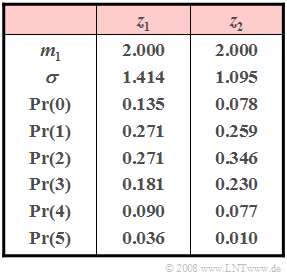Difference between revisions of "Aufgaben:Exercise 2.5: "Binomial" or "Poisson"?"
| (One intermediate revision by the same user not shown) | |||
| Line 35: | Line 35: | ||
<quiz display=simple> | <quiz display=simple> | ||
| − | {Find out from the probabilities, means, and | + | {Find out from the probabilities, means, and standard deviations whether $z_1$ or $z_2$ is Poisson distributed. |
|type="()"} | |type="()"} | ||
+ $z_1$ is Poisson distributed and $z_2$ is binomially distributed. | + $z_1$ is Poisson distributed and $z_2$ is binomially distributed. | ||
| Line 67: | Line 67: | ||
{{ML-Kopf}} | {{ML-Kopf}} | ||
'''(1)''' Correct is the <u>proposed solution 1</u>: | '''(1)''' Correct is the <u>proposed solution 1</u>: | ||
| − | *In the Poisson distribution, mean $m_1$ and variance $\sigma^2$ are equal. | + | *In the Poisson distribution, mean $m_1$ and variance $\sigma^2$ are equal. |
*The random variable $z_1$ satisfies this condition in contrast to the random variable $z_2$. | *The random variable $z_1$ satisfies this condition in contrast to the random variable $z_2$. | ||
| − | '''(2)''' Moreover, in the Poisson distribution, the mean is equal to the rate. Therefore, $\underline{\lambda = 2}$ must hold. | + | |
| + | '''(2)''' Moreover, in the Poisson distribution, the mean is equal to the rate. Therefore, $\underline{\lambda = 2}$ must hold. | ||
| Line 77: | Line 78: | ||
:$${\rm Pr}(z_1 = 6)=\frac{2^6}{6!}\cdot e^{-2}\hspace{0.15cm} \underline{\approx 0.012}$$ | :$${\rm Pr}(z_1 = 6)=\frac{2^6}{6!}\cdot e^{-2}\hspace{0.15cm} \underline{\approx 0.012}$$ | ||
:$${\rm Pr}(z_1 > 6)=1 -{\rm Pr}(0) -{\rm Pr}(1) - \ \text{...} \ -{\rm Pr}(6)\hspace{0.15cm} \underline{\approx 0.004}.$$ | :$${\rm Pr}(z_1 > 6)=1 -{\rm Pr}(0) -{\rm Pr}(1) - \ \text{...} \ -{\rm Pr}(6)\hspace{0.15cm} \underline{\approx 0.004}.$$ | ||
| + | |||
'''(4)''' For the variance of the binomial distribution holds: | '''(4)''' For the variance of the binomial distribution holds: | ||
| Line 83: | Line 85: | ||
*The characteristic probability of the binomial distribution is obtained from the variance $\sigma^2 = 1.095$ and the mean $m_1 = 2$ according to the equation: | *The characteristic probability of the binomial distribution is obtained from the variance $\sigma^2 = 1.095$ and the mean $m_1 = 2$ according to the equation: | ||
:$$ 1- p = \frac{\sigma^{2}}{m_1}= \frac{1.2}{2} = 0.6\hspace{0.3cm}\Rightarrow \hspace{0.3cm} p \hspace{0.15cm} \underline{= 0.4}.$$ | :$$ 1- p = \frac{\sigma^{2}}{m_1}= \frac{1.2}{2} = 0.6\hspace{0.3cm}\Rightarrow \hspace{0.3cm} p \hspace{0.15cm} \underline{= 0.4}.$$ | ||
| + | |||
'''(5)''' From the mean $m_1 = 2$ it further follows $\underline{I= 5}.$ | '''(5)''' From the mean $m_1 = 2$ it further follows $\underline{I= 5}.$ | ||
| − | *The probability | + | *The probability for the outcome "0" would have to be as follows with these parameters: |
:$${\rm Pr}(z_2 = 0)=\left({5 \atop {0}}\right)\cdot p^{\rm 0}\cdot (1 - p)^{\rm 5-0}=0.6^5=0.078.$$ | :$${\rm Pr}(z_2 = 0)=\left({5 \atop {0}}\right)\cdot p^{\rm 0}\cdot (1 - p)^{\rm 5-0}=0.6^5=0.078.$$ | ||
Latest revision as of 16:10, 16 February 2022
Consider two discrete random variables $z_1$ and $z_2$ that can take (at least) all integer values between $0$ and $5$ (including these limits).
The probabilities of these random variables are given in the adjacent table. However, one of the two random variables is not limited to the given range of values.
Furthermore it is known that
- one of the variables is binomially distributed, and
- the other describes a Poisson distribution.
However, it is not known which of the two variables $(z_1$ or $z_2)$ is binomially distributed and which is Poisson distributed.
Hints:
- This exercise belongs to the chapter Poisson distribution.
- But also refers to the previous chapter Binomial Distribution.
- To check your results you can use the interactive HTML5/JavaScript applet Binomial and Poisson distribution.
Questions
Solution
- In the Poisson distribution, mean $m_1$ and variance $\sigma^2$ are equal.
- The random variable $z_1$ satisfies this condition in contrast to the random variable $z_2$.
(2) Moreover, in the Poisson distribution, the mean is equal to the rate. Therefore, $\underline{\lambda = 2}$ must hold.
(3) The corresponding probability is with $z_{\rm Poisson} = z_1$:
- $${\rm Pr}(z_1 = 6)=\frac{2^6}{6!}\cdot e^{-2}\hspace{0.15cm} \underline{\approx 0.012}$$
- $${\rm Pr}(z_1 > 6)=1 -{\rm Pr}(0) -{\rm Pr}(1) - \ \text{...} \ -{\rm Pr}(6)\hspace{0.15cm} \underline{\approx 0.004}.$$
(4) For the variance of the binomial distribution holds:
- $$\sigma^{2}= I\cdot p\cdot (1- p)= m_{\rm 1}\cdot ( 1- p).$$
- The characteristic probability of the binomial distribution is obtained from the variance $\sigma^2 = 1.095$ and the mean $m_1 = 2$ according to the equation:
- $$ 1- p = \frac{\sigma^{2}}{m_1}= \frac{1.2}{2} = 0.6\hspace{0.3cm}\Rightarrow \hspace{0.3cm} p \hspace{0.15cm} \underline{= 0.4}.$$
(5) From the mean $m_1 = 2$ it further follows $\underline{I= 5}.$
- The probability for the outcome "0" would have to be as follows with these parameters:
- $${\rm Pr}(z_2 = 0)=\left({5 \atop {0}}\right)\cdot p^{\rm 0}\cdot (1 - p)^{\rm 5-0}=0.6^5=0.078.$$
- This means: Our results are correct.
